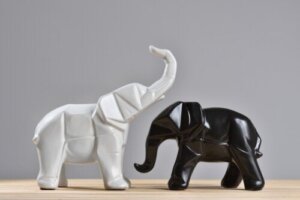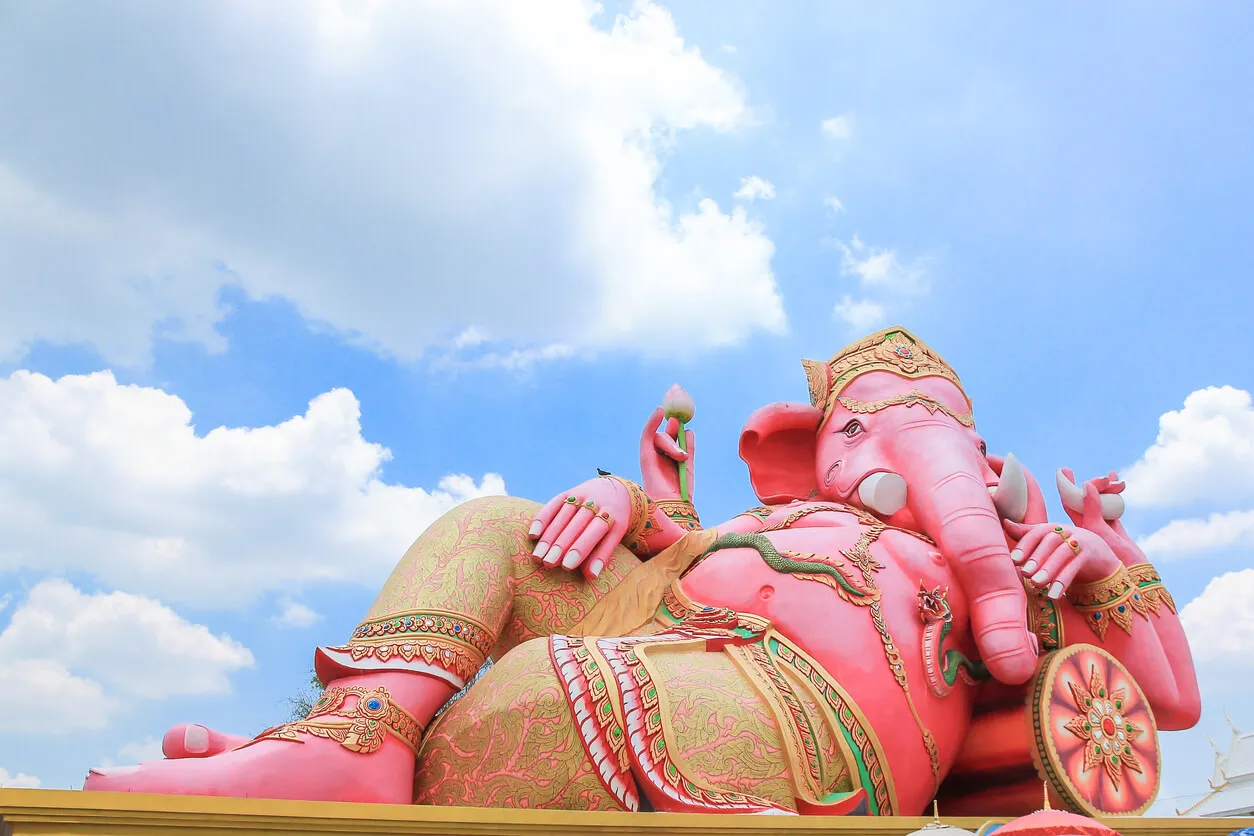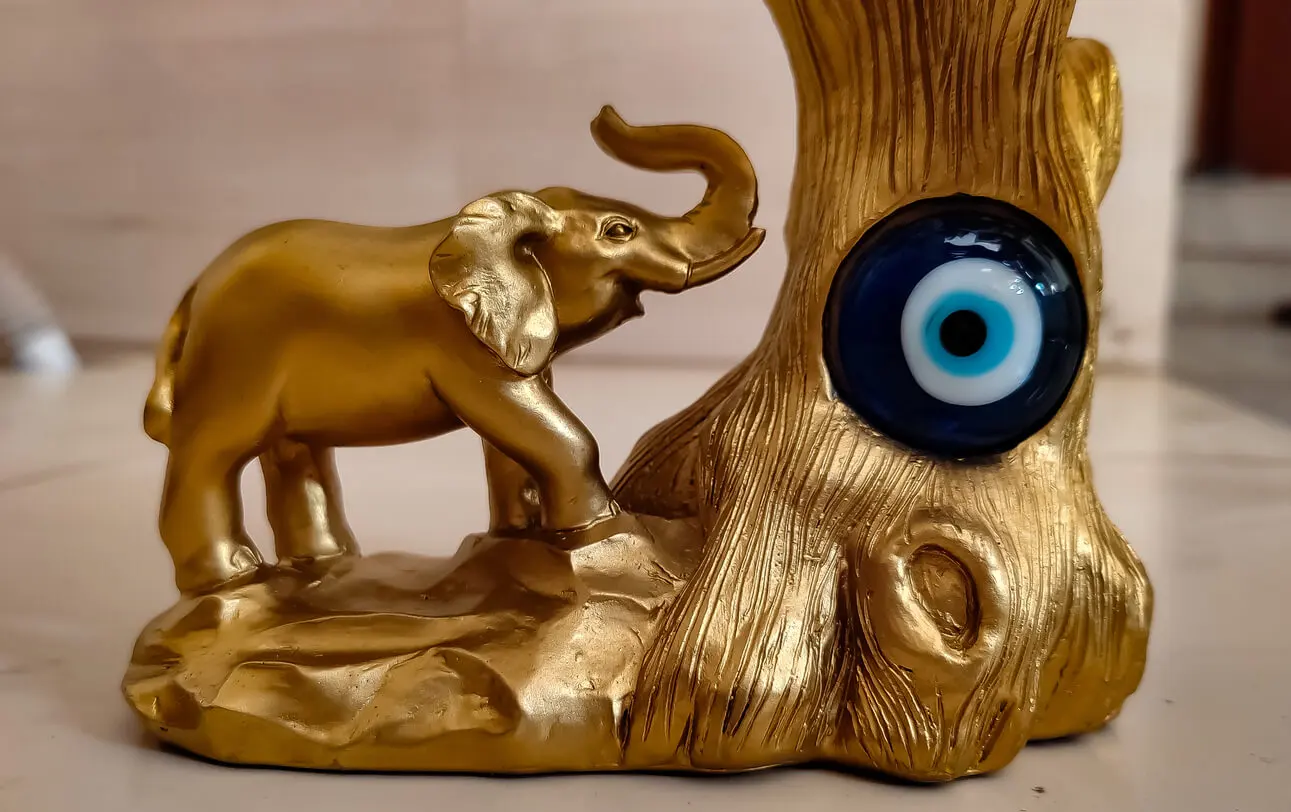Elephants in Decoration: What is Their Meaning?

The symbols, ornaments, and images that we place in the home always have a meaning. This comes not only by the type of figure they represent, but also by the room where they’re located and the position in which they’re placed. In the case of elephants in the decoration, the objective may vary according to what you’re looking for.
There’s no doubt that this animal is an imposing figure in nature. It expresses strength, wisdom, memory, and family ties, among other attributes.
Therefore, many cultures have decided to include it in their practices. It’s even the form of a central deity in Hinduism. If you have elephants in the decoration of your home, learn their specific meanings to take advantage of their essence.
What do elephants represent in decoration?
Elephants are a very particular species within the animal kingdom. Their imposing size, combined with an apparent passivity, has aroused human admiration for centuries. In the wild, this species has very marked social behaviors. Herds are usually led by females and move in groups with their young.
In addition, highly complex social structures are recognized, as well as behaviors of play, compassion, self-awareness, and tool use. All these attributes made humans pay attention to them and incorporate them into their culture in many different ways.
Elephants in decoration can represent good fortune, willpower, perseverance, fertility, and spiritual well-being, and even be a central part of the Hindu pantheon. This animal is also the representation of Ganesha, one of the most important figures of a centuries-old religion. However, all these meanings depend on the place where the elephant ornament is located, as well as its position and color.

We think you may be interested in reading this, too: How to Integrate Vintage Wallpaper into Your Home Decoration
Elephants in decoration are a multicultural practice
The numerous attributes that elephants have by nature, as well as the symbolic characteristics that humans assign to them, make this figure very present. Different cultures have incorporated them for centuries in legends, traditions, and all kinds of cultural manifestations.
For some it represents fidelity, for others, it improves their family relationship, due to the natural behavior of the species. In certain contexts, elephants transmit protection and affection.
They are also used in many Latin American practices, where they appear more associated with the search for good fortune. In this case, the posture of the trunk is fundamental, which must be upward to generate the desired effect.
Hinduism
In the millenary religion of Hinduism, the elephant occupies a central place representing the god Ganesha, a hybrid figure with the head of an animal and a human body. Ganesha is a deity associated with abundance, but also with science and art.
The cult of Ganesha is wide and varies according to the branch of religion; it even reached Buddhism. In his four arms, he carries different objects, which can also vary.
In general, he carries a rope, related to spiritual guidance; an axe, intended to cut the bonds of his devotees; a laddu, a stuffed sweet that’s typical of the area; and a golden mace, linked to self-control. Possessing a Ganesha figure in the home is very common in this religion and has a deeper and more spiritual meaning than simple decoration.
Feng shui
The presence of elephants also takes on profound meanings in the Chinese philosophy of feng shui. This practice, which teaches how to generate peaceful environments and improve the energies of the home according to the arrangement of objects, links the elephant with strength.
However, it also works to attract good luck and generate harmony in family ties. The way to position the object varies according to the personal search that one has.
Elephants in your decoration depending on the space of the home
As much as feng shui and other disciplines of spiritual and decorative order use the figure of the elephant with different meanings depending on the space it occupies. If you have an ornament of this animal, discover how to use it to associate it with your desires and needs.
The bedroom
A common use for elephant ornaments is to place them in the bedroom, especially if you live with a partner. This is because its figure is associated with harmony in love relationships.
In this case, it can be present through paintings or textiles. The important thing is that the animal is with the trunk down; something that is also linked to fertility.
Children’s bedrooms
For the little ones, an elephant in the room is related to the search for wisdom. If the youngster is in elementary or higher education, the presence of this animal is meant to strengthen memory and knowledge.
Elephants in office decor
One of the most common spaces where these decorations appear is in work areas. Whether it’s in a home telecommuting space, in a coworking space, or in a traditional office, the elephant enhances the attributes of leadership and perseverance. It’s an ideal figure for those who pursue professional growth.

The reception area
It’s possible to welcome guests through the elephant figure. For that, it should be positioned near the entrance door and facing the interior of the room. If what is intended is to keep away negative energies, place it facing outward.
Like this article? You may also like to read: Cozy Decoration: What Is It and How Can I Implement It?
Other symbolisms of elephants in the decoration
Beyond the room that occupies the ornament within the room, some meanings vary depending on the type of object. For example, getting two elephants together or intertwined symbolizes love and friendship.
It’s also common to see these ornaments with a bill rolled up in the trunk. This is a practice that seeks to attract fortune and economic well-being. To put it into operation, a bill of any value must be rolled up in the trunk of the ornament, but it has to be done on the 29th of the month. Then, at the end of the following month, the money is removed and replaced by another; the same every 29th day.
The importance of posture for elephants in decoration
Just like the direction of the body or the posture of the trunk in the room, it’s important that the elephant’s trunk is always facing upwards. This means that the search aims to attract positive things.
On the other hand, you can add accessories somewhere in the decoration. It’s possible to incorporate objects with a deep meaning to hold in the arms, as the deity Ganesha does.
All cited sources were thoroughly reviewed by our team to ensure their quality, reliability, currency, and validity. The bibliography of this article was considered reliable and of academic or scientific accuracy.
- Lotito Catino, Franco, Arquitectura psicología espacio e individuo. Revista AUS [Internet]. 2009; (6):12-17. Recuperado de: https://www.redalyc.org/articulo.oa?id=281723479003
- Cha Liang G, Osmadi A. THE SIGNIFICANCE OF FENG SHUI IN HOUSE BUYING SELECTION AMONG MALAYSIANS. Jurnal Teknologi [Internet]. 2015Aug.20 [cited 2022Apr.3];75(9). Available from: https://journals.utm.my/jurnalteknologi/article/view/5218
- Vander Velden, Felipe, Preciosa naturaleza: los animales como joyas y ornamento en el tráfico de fauna silvestre. Tabula Rasa [Internet]. 2019; (32):127-156. Recuperado de: https://www.redalyc.org/articulo.oa?id=39661317007
- Ramchandani, Juan Carlos. “Análisis Introductorio Del Hinduismo.” Dialnet 18 (2016): 1–8. Dialnet. Web. Disponible en: https://repositorio.uam.es/bitstream/handle/10486/677819/EM_52_8.pdf?sequence=1&isAllowed=y
- Gómez A., José Arlés, LA CONCIENCIA EN EL HINDUISMO: LECTURA DESDE LA OBJETIVIDAD Y SUBJETIVIDAD DE LA CONCIENCIA UNIFICADA. Hallazgos [Internet]. 2006; (6):133-148. Recuperado de: https://www.redalyc.org/articulo.oa?id=413835165009
This text is provided for informational purposes only and does not replace consultation with a professional. If in doubt, consult your specialist.








